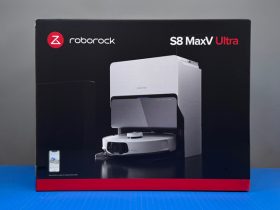Only days after we reported on an updated Aqara D100 smart lock that adds Zigbee and Apple HomeKey functionality to a previous model, Aqara has now unveiled yet another smart lock. As expected, the Xingyao (‘Starshine’ in English) or S100 Smart Lock includes a raft of features, although strangely enough, unlike the recent Aqara locks A100 Pro/Zigbee and the aforementioned D100 Zigbee, the Xingyao doesn’t come with Apple HomeKey functionality.
Still, it does come with a few couple of features these locks don’t, one of which may make it appeal to those with an eye for colour coordination.
The S100 is a fully automatic smart lock, like the D100 Zigbee, that allows not only that latch bolt to disengage, but also retracts the mortice bolts, so there’s no need to pull a handle, like is required for many other Aqara locks, including the recently released A100 Zigbee/Pro. Another interesting development with the new product is that this ‘Lock’ isn’t actually a lock, as the mortice lock part is sold separately from the exterior parts. The reason for this is that, should you already have a compatible (6068) mortice lock from a previous installation, you can simply replace the outer parts with the parts from the S100, and keep your already installed mortice lock mechanism.
Another unique feature is the option to switch out the removable covers for the lock, with five different finishes to suit your decor.
Each set of replacable faschia come in a different colour way to (hopefully) match your home’s theme, with Natural Wood, Stone Blue, Cinnabar, Oat Latte, and Graphite (lit. trans. Green Ink) being the options available.
If you’re familiar with Aqara locks, then you’ll recognise the unlock methods they offer, which includes a fingerprint sensor built into the handle, a keypad for permanent or temporary passcodes, Bluetooth connectivity for direct connection between lock and smartphone, NFC unlocking with the Aqara NFC Keycard, unlock via Apple Home and Aqara Home apps, as well as emergency keys, if all else fails.
What the lock doesn’t feature is a Zigbee radio, which we’ve seen with both the previously mentioned locks. However, it makes up for that (if it’s considered a bonus), with the inclusion of a built-in doorbell, a proximity sensor to detect when someone is near your door for any more than a couple of seconds, and a full 1080p resolution camera. Because of the camera, the lock also uses WiFi, as neither Zigbee nor Bluetooth have the neccessary bandwidth to cope with live video streams. The video camera has a large 161º field of view, and works in tandem with the proximity sensor to record whatever is in front of it, with the recordings being uploaded to Aqara’s cloud storage facility. The recordings are stored free for 7 days.
It should be noted that neither the doorbell, proximity sensor, nor the video camera is exposed to HomeKit.
The lock comes with a rechargeable lithium battery. According to the Q&A section for the S100 on Aqara’s website regarding battery life, it states;
under normal conditions, when recording 10 short videos with a duration of 10s (5 videos each day and night) according to the door lock trigger every day, and open and close the door. Under the premise of 10 times, the camera function is expected to last 120 days, and the door lock function is expected to last 140 days. The battery life will be affected by factors such as the number of triggered video recordings, the number of live broadcasts, the length of live broadcasts, the ambient temperature, and the network environment.
To recharge the battery, you can remove it and use a type C cable connected to a suitable power supply. If the lock’s batteries die unexpectedly, you can temporarily power the lock with a power pack, connecting it to the lock via its built-in USB-C port.
There’s no word on pricing yet, but as you might have gathered, this lock is destined for Chinese consumers only, although that doesn’t seem to stop some determined Aqara/HomeKit fans!
You can check out our video of the Aqara A100 Zigbee below, or read the full written review HERE;
Thanks to Eric Yao at Wave.tech for the heads up.



